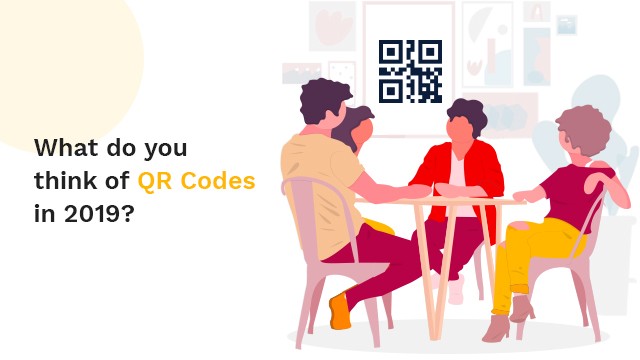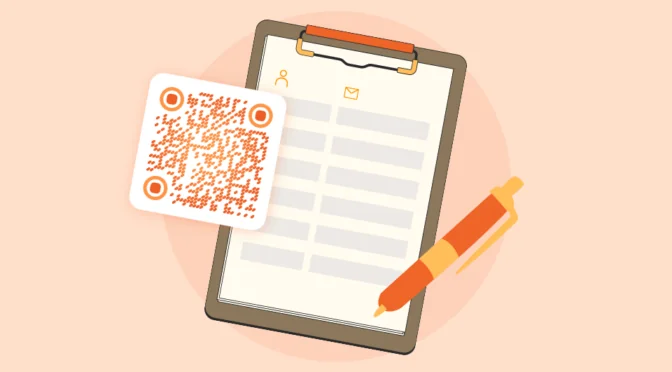When I was writing this blog post “Are QR Codes still relevant in 2019?”, I saw that there was a sizeable search volume for these terms – ‘Are QR Codes dead?’ and ‘Will they make a comeback in 2019?’
I trust the data. By 2020, 11 million households in the US alone will scan a QR Code. Brands like Calvin Klein, Nike, Adidas, Puma, Tommy Hilfiger, Decathlon have all used QR Codes as a part of their marketing strategy.
Table of Contents
- 4 founders, 2 digital marketers, and 1 city council candidate talk about QR Codes –
- When QR Codes streamlines the check-out process and saves the environment
- When QR Codes improve the efficacy of print marketing
- When QR Codes help run loyalty programs and get valuable feedback
- When QR Codes boost your brand image
- Why QR Codes are so popular in the East?
- When QR Codes make everyday life a lot easier
- When QR Codes encourage youth voter registration
- The future of QR Codes: 2019 and beyond
But is data being tortured to manipulate facts or do marketers, business owners, and millennials really find that QR Codes add a ton of value?
So I decided to ask them two things: Have you used QR Codes and did it work for you?
Here is what 4 founders, 2 digital marketers, and 1 City Council Candidate have to say about QR Codes in 2019:
STREAMLINE CHECKOUT EXPERIENCE
#1 When QR Codes streamline the customer’s checkout experience and saves the environment.
QuickReceipts delivers digital receipts through QR Codes helping consumers make an eco-friendly choice and save time at checkout. No email, no phone number, and no app is required. Aside from saving the environment by reducing the amount of paper, QuickReceipts also plants a tree for every 25,000 receipts generated using their API.
“I think the fascinating thing about QR codes is that they were invented 25 years ago, and in the past few years, they’ve come back into the picture, particularly in the US. I talk about this a bit in my blog post, but, to me, it was a mixture of social media companies utilizing their own form of QR codes to quickly exchange information, along with smartphone manufacturers building QR code readers into their cameras, that really helped QR codes take off again in the US. Now they’re everywhere, from mobile coupons to scooters and even in some wearable technology applications.
In the same way that people use QR codes to scan for more information or exchange contact information, we think QR codes are an excellent way for people to get their receipts. Not only do 85% of people in the US own a smartphone (according to Deloitte), but we believe it’s one of the most private ways to get a receipt at the register. You simply just point your smartphone camera at a QR code to get your receipt – no need to input your email or phone number while you’re at the register, and no need for paper that ultimately ends up in the trash.”
Paul Tran
Co-Founder, QuickReceipts
Minnesota, US
DRIVE MORE TRAFFIC
RELATED: QR Codes on receipts can also help you increase repeat customers
#2 When QR Codes improve the efficacy of print marketing
Traditional marketers have been missing the one thing that digital marketers can easily get their hands on – engagement metrics. When you add dynamic QR codes into the mix, you can not only track the conversion rates and fine-tune your campaign, but you also make the user’s journey that much easier.
To create these trackable dynamic QR Codes, you need the absolute best dynamic QR Code Generator that’s both easy to use and gives you the right analytics.
Consider the case of direct mail marketing. 77% of customers still sort through their physical mails and 98% of Americans check their mailboxes every single day. By placing a QR code on these direct mailers, marketers are finally able to design a user journey, measure conversion rates, direct sales and start retargeting interested users.
Read: Inkit’s Ultimate Guide to QR Code Marketing for Direct Mail
All Print Resources is a prime example of how the marriage of traditional print marketing and QR Codes is a recipe for success. Leveraging the power of QR Codes, their clients have been able to deliver personalized promotions and drive both online and in-store traffic with great ease.
“More of our clients are using QR Codes to drive traffic to their website for general ads, gather information, as well as hyper-targeted promotions.
One recent project comes to mind where we worked with a local retailer to create a unique QR Code on a point of sale marketing piece for high ticket products. The QR code allowed the user to view all of the product details online, financing options and a way to connect with a sales person.
Another interesting project we recently completed was a direct mail piece to drive traffic to a client’s trade show booth. Recipients received unique QR Codes that generated a combination to open a treasure chest at a booth to receive valuable gifts.
We are helping clients bridge the gap and between print and digital marketing.”
Joe Dec
President, All Print Resources
New Jersey, US
LEVERAGE LOYALTY AND FEEDBACK
#3 When QR Codes help you run customer loyalty programs and get valuable feedback
I’ve always found signing up for a loyalty program an arduous task. You have to spend precious time spelling out your name and giving away your contact information while you receive death stares for holding up the line.
If a business doesn’t make it easy for customers to join their loyalty programs, they could potentially miss out on 52.3% of customers that do want to join a loyalty program. The key to getting customers to sign up for VIP programs is customer experience. According to Dimensional Research, 59% of customers say that one bad experience is enough to make them stop going back to the same store and 55% of them would instead go to a competitor.
Zapacard solves two problems with one technology – QR Codes. By creating a QR Code to run loyalty programs and asking for customer feedback, Zapacard users are able to achieve a much higher ROI and implement customer feedback making the customers feel heard.
“Now that QR codes have become native functionality in all the phone platforms they are incredibly powerful. We provide each client with a set of unique codes that they can use to run their loyalty and feedback. They can simply ask customers to point their phone at the relevant code to run set functions. Knowing their customer’s phone will support this means they don’t have to worry about installing or maintaining any equipment themselves. With unique QR codes, we can easily scale their functions without having to have logins or other heavy solutions on our end.”
Brian O’Connell,
Owner, Zapacard
Ireland
INCREASE BRAND VISIBILITY
#4 When QR Codes boost your brand image
Flyers, the OG of proximity marketing, are still around to this day. However, unless the flyer is aesthetically appealing, follows human-centric design principles and has a compelling CTA, the ROI you’re looking at is pretty low. Also, there is no real way to measure the effectiveness of the flyer. For those looking to create visually appealing flyers easily, using a free flyer maker can be a great solution.
By including a QR Code on the flyer, you can bridge the offline and online world. You can have users call you, add your event to their calendar, visit your website, navigate to your location and more.
Read: How to create a QR Code for your OOH ads
This is exactly how Shantanu, a digital marketer, used QR codes on flyers in a recent project. The target audience didn’t spend hours online so Search Engine Marketing wouldn’t work so he did the next best thing – added a QR code leading to the website on the flyers.
“The business was very niche – LIVE online coaching for Indian Civil Services aspirants, and these students don’t engage with the internet as frequently on a daily level as others. I figured that QR codes could be a great way to make users land on our high-intent pages via physical mediums like flyers. And it worked! We got considerable traffic during a peak seasonal time of the year, which we could trace back to the QR codes from the flyers! Although we didn’t get any conversions, it definitely boosted the branding for the company”
Shantanu Chatterjee,
Digital Marketer
New Delhi, India
QR CODE USAGE IN 2019
You may want to know: Convert PDFs to QR Codes
#5 Why QR Codes are so popular in the east
When you look at QR Codes today, you will find dozens of everyday use cases from China, Japan, Korea, and India. Invariably, these countries primarily use QR codes for making payments, receiving offers, and unlocking coupons.
And while the countries in the West have been playing catch up, I’ve seen incredibly unique use cases come out of it.
Teachers use QR codes as an educational tool. QR codes are used on study guides, in scavenger hunts, to deliver assignments and mark attendance. QR Codes are a welcome addition at museums to curate an unguided tour for new and frequent museum-goers. Cryptocurrency exchanges allow you to scan a QR code that contains your wallet address to send crypto coins, like Render after the transaction is complete. Crypto heatmaps can also be used to track changes and make well-informed decisions. Using the best crypto app simplifies this process further, allowing users to scan QR codes to manage transactions efficiently. Understanding the implications of crypto taxes is essential, especially since every transaction, even those completed using QR codes at exchanges, can be subject to taxation depending on your jurisdiction. In some cases, you can even consult with crypto marketing agencies and other professionals to get some professional support. The guideline may explain the crypto payment and crypto tax procedures in detail. For seamless integration of these technologies, crypto development companies like Blocktech Brew can help businesses leverage QR codes to enhance user experience.”
Stephanie Melodia runs Bloom, a full-service marketing agency, and has had the opportunity to witness the contrast in QR code usage in the east and the west.
“When one learns the Quick Response Code (or as we know it, the QR code) was invented in Japan for the automotive industry, it becomes a little more understandable as to how these blotchy, monochromatic patches are so much more prolific in the East than they are over here in Europe or the States. The simple and yet so advanced technology employed in these codes makes it hard to argue why it hasn’t caught on as much in the rest of the world, other than the simple explanation in the age-old “fashion VS function” battle.
Throughout history, we’ve seen incredibly useful new technologies emerge, however, due to timings in terms of general trends on a macro level and varying degrees of social acceptance, these things simply do not catch on. We saw this with the fork (which was invented in the 4th Century but took another 1,100 years to become widely used and accepted – thanks to the Medici family, European cinquecento’s answer to our Kardashians). We saw it with Google Glass more recently, and even now we see it with Japanese high-tech toilets. These inventions are functional and serve a useful purpose. But sometimes, they’re just too ugly for our place in society right now.
Before setting up my own agency, Bloom, I was fortunate enough to work for Top 10 Global App Developer, a huge Chinese company called Meitu. During my tenure with the firm, I got to travel between east and west and see for myself the myriad of cultural differences – and one of these was most definitely the QR code. In China, QR codes are as commonplace as brand’s force-feeding desperate hashtags here in the West. They are certainly there to stay, however time will tell if they will ever fully manage to permeate our Western marketplace.”
Stephanie Melodia,
Director at Bloom
London, UK
QR CODES IN CHINA
#6 When QR codes make everyday life a lot easier
When you think of QR codes, you instantly picture China and how WeChat’s QR codes that have completely revolutionized the country.
Michael Harding, the founding member of the China Collective, uses QR codes every day and is surprised that other countries are still playing catch to this seemingly obvious cost-effective technology.
“Pictures cannot explain the full scale of how and why QR codes are used and why they are a very good tool for everything from payments to accessing information. There are many ways in which QR codes are used in China. In fact, I use QR codes every single day here for my day to day life. It’s definitely better. I say this because recently I advertised an event in Brisbane, Australia and I had to advertise a full website address (URL) to direct people to register for the event and it showed just how clunky and outdated the use of website URLs is vs QR codes. There are two fundamental uses for QR codes, Accessing information sources such as websites or APPs via scanning a QR code vs manually typing in a URL. And secondly, for payments. Whilst the QR code is not the digital wallet itself, but by using the WeChat or Alipay QR code scanner and your assigned QR code, you can efficiently load a payment screen via a quick scan of a shops QR code and key in the payment amount and confirm payment instantly. ”
Michael Harding
MBH Consulting – Helping you do business in China
The China Collective, Founding Member
Australia/China
ENCOURAGE YOUNG VOTERS
#7 When QR Codes encourage youth voter registration
We know how social media and tech can completely change the outcome of an election. But, what happens when young adults don’t register to vote? It threatens the very essence of democracy. However, QR codes can serve various purposes beyond technical applications. For example, companies like Patagonia have used QR codes creatively on their personalized t-shirts, allowing customers to scan and access exclusive content, product information, or interactive experiences directly from their clothing.
Read: How to use a Facebook QR Code for business and personal use
I happened to come across these QR Code T-shirts created by activists behind March for Our Lives who wanted to mobilize young potential voters and got in touch with Catherine Garcia Flowers, City Council Candidate who had promoted it on her social media platforms.
“The QR code t-shirts made by the young March for Our Lives activists are truly a game-changer in influencing how we engage in modern politics. We have seen the rise of social media as a method for campaigns, which I myself have harnessed as a powerful tool running for City Council At-Large. In this particular case, however, you don’t even need a certain app—simply point your phone camera at the QR code—on the shirt itself or through an image of the shirt—and it invites you to register to vote. This is the future of youth activism: creating platforms that make your political involvement accessible and even fashionable. Since this shirt has no specific partisan or regional limitations, even I have promoted it as a way of encouraging people to register in time for Houston’s local elections in November.”
Catherine Garcia Flowers,
City Council Candidate at Large #5
Texas, US
The Future of QR Codes: 2019 and beyond
QR Codes already have a strong foothold as a payment method. Ghana and Russia have recently announced their intention to roll out a QR-code based payment. Alipay is also working with 6 European digital wallets to bring QR codes to Europe.
It doesn’t stop there. QR Codes have entered the realm of endless possibilities. Puma’s LQD Cell shoes and IKEA’s direct mailers included QR Codes to successfully deliver AR experiences to consumers.
Read: QR Codes for the Retail Industry in 2019: 6 Brands Doing It Right
It is also pretty easy to automate the process of creating QR Codes using a QR Code API saving a ton of time when bulk QR Codes are required.
Given how customizable and flexible QR codes are, it is no wonder big brands and SMBs are finally realizing the true potential of QR codes. Not only can business owners and marketers design a seamless user journey but they can also elevate traditional forms of marketing.
Got a question about QR Codes? Want to know how you can incorporate it into your marketing strategy? Ask our QR Code experts today!










